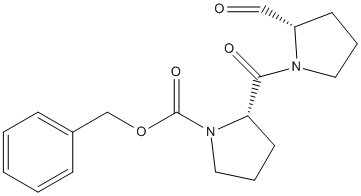Z-Pro-Prolinal
General
Type : Benzyloxycarbonyl,Peptide,Pyrrolidine,Carbamate
Chemical_Nomenclature : benzyl (2S)-2-[(2S)-2-formylpyrrolidine-1-carbonyl]pyrrolidine-1-carboxylate
Canonical SMILES : C1CC(N(C1)C(=O)C2CCCN2C(=O)OCC3=CC=CC=C3)C=O
InChI : InChI=1S\/C18H22N2O4\/c21-12-15-8-4-10-19(15)17(22)16-9-5-11-20(16)18(23)24-13-14-6-2-1-3-7-14\/h1-3,6-7,12,15-16H,4-5,8-11,13H2\/t15-,16-\/m0\/s1
InChIKey : ORZXYSPOAVJYRU-HOTGVXAUSA-N
Other name(s) : N-benzyloxycarbonyl-l-prolyl-l-prolinal,N-Benzyloxycarbonyl-prolyl-prolinal,CHEMBL79993,PRD_000692,ZPP,ZPR,BRN 4821785
MW : 330.37
Formula : C18H22N2O4
CAS_number : 86925-97-5
PubChem : 122623
UniChem : ORZXYSPOAVJYRU-HOTGVXAUSA-N
IUPHAR :
Wikipedia :

Target
Families : Z-Pro-Prolinal ligand of proteins in family: S9N_PPCE_Peptidase_S9
Stucture :
Protein : pig-ppce || aerpu-PEP || 9gamm-MaPOP
References (5)
| Title : The structure and molecular dynamics of prolyl oligopeptidase from Microbulbifer arenaceous provide insights into catalytic and regulatory mechanisms - Huang_2022_Acta.Crystallogr.D.Struct.Biol_78_735 |
| Author(s) : Huang, P , Lv A , Yan Q , Jiang Z , Yang S. |
| Ref : Acta Crystallographica D Biol Crystallogr , 78 :735 , 2022 |
| Abstract : Huang_2022_Acta.Crystallogr.D.Struct.Biol_78_735 |
| ESTHER : Huang_2022_Acta.Crystallogr.D.Struct.Biol_78_735 |
| PubMedSearch : Huang_2022_Acta.Crystallogr.D.Struct.Biol_78_735 |
| PubMedID: 35647921 |
| Gene_locus related to this paper: 9gamm-MaPOP |
| Title : Molecular insight into the enzymatic macrocyclization of multiply backbone N-methylated peptides - Matabaro_2022_bioRxiv__ |
| Author(s) : Matabaro E , Song H , Sonderegger L , Gherlone F , Giltrap A , Liver S , Gossert A , Kunzler M , Naismith JH |
| Ref : Biorxiv , : , 2022 |
| Abstract : Matabaro_2022_bioRxiv__ |
| ESTHER : Matabaro_2022_bioRxiv__ |
| PubMedSearch : Matabaro_2022_bioRxiv__ |
| PubMedID: |
| Gene_locus related to this paper: ompol-OphP |
| Title : Induced-fit mechanism for prolyl endopeptidase - Li_2010_J.Biol.Chem_285_21487 |
| Author(s) : Li M , Chen C , Davies DR , Chiu TK |
| Ref : Journal of Biological Chemistry , 285 :21487 , 2010 |
| Abstract : Li_2010_J.Biol.Chem_285_21487 |
| ESTHER : Li_2010_J.Biol.Chem_285_21487 |
| PubMedSearch : Li_2010_J.Biol.Chem_285_21487 |
| PubMedID: 20444688 |
| Gene_locus related to this paper: aerpu-PEP |
| Title : Electrostatic effects and binding determinants in the catalysis of prolyl oligopeptidase. Site specific mutagenesis at the oxyanion binding site - Szeltner_2002_J.Biol.Chem_277_42613 |
| Author(s) : Szeltner Z , Rea D , Renner V , Fulop V , Polgar L |
| Ref : Journal of Biological Chemistry , 277 :42613 , 2002 |
| Abstract : Szeltner_2002_J.Biol.Chem_277_42613 |
| ESTHER : Szeltner_2002_J.Biol.Chem_277_42613 |
| PubMedSearch : Szeltner_2002_J.Biol.Chem_277_42613 |
| PubMedID: 12202494 |
| Gene_locus related to this paper: pig-ppce |
| Title : Prolyl oligopeptidase: an unusual beta-propeller domain regulates proteolysis - Fulop_1998_Cell_94_161 |
| Author(s) : Fulop V , Bocskei Z , Polgar L |
| Ref : Cell , 94 :161 , 1998 |
| Abstract : Fulop_1998_Cell_94_161 |
| ESTHER : Fulop_1998_Cell_94_161 |
| PubMedSearch : Fulop_1998_Cell_94_161 |
| PubMedID: 9695945 |
| Gene_locus related to this paper: pig-ppce |